Introduction
In the competitive landscape of cloud computing, effective cost management has become a cornerstone for organizations striving to maximize their investments in AWS. Understanding the intricacies of AWS pricing models—ranging from pay-as-you-go to reserved instances and spot instances—empowers businesses to unlock significant savings while optimizing resource allocation.
The shift toward strategic cost management is underscored by the recognition that cloud computing serves not only as a platform for innovation but also as a vital component of modern financial strategies.
This article delves into key concepts and advanced techniques for AWS cost optimization, offering insights into practical strategies such as:
- Right-sizing
- Leveraging AWS tools
- Implementing advanced cost reduction methods
By mastering these strategies, organizations can enhance their operational agility, achieve substantial cost reductions, and position themselves for sustained success in the cloud.
Understanding AWS Cost Optimization: Key Concepts and Benefits
AWS cost optimization necessitates a comprehensive understanding of the various pricing models offered, including:
- Pay-as-you-go
- Reserved options
- Spot offerings
By effectively leveraging these models, organizations can implement AWS cost reduction strategies to achieve substantial financial savings. For instance, utilizing Amazon EC2 Spot Instances allows businesses to run fault-tolerant workloads while accessing discounts of up to 90%.
This strategic alignment between cloud usage and business needs optimizes resource allocation and enhances operational agility. As Cody Slingerland observes, "The U.S. and Western Europe still dominate cloud computing," emphasizing the significance of understanding regional trends in efficiency improvement. Furthermore, AWS cost reduction strategies, including AWS Savings Plans, exemplify a cost-effective approach that enables customers to secure significant savings by committing to a consistent amount of compute usage over one or three years.
Significantly, half of surveyed enterprises now regard cloud computing as a contemporary data protection approach, reinforcing the importance of these financial optimization strategies in enhancing overall business resilience. Mastering these concepts is essential for implementing robust financial management strategies, particularly AWS cost reduction strategies, that can lead to significant reductions in expenses over time.
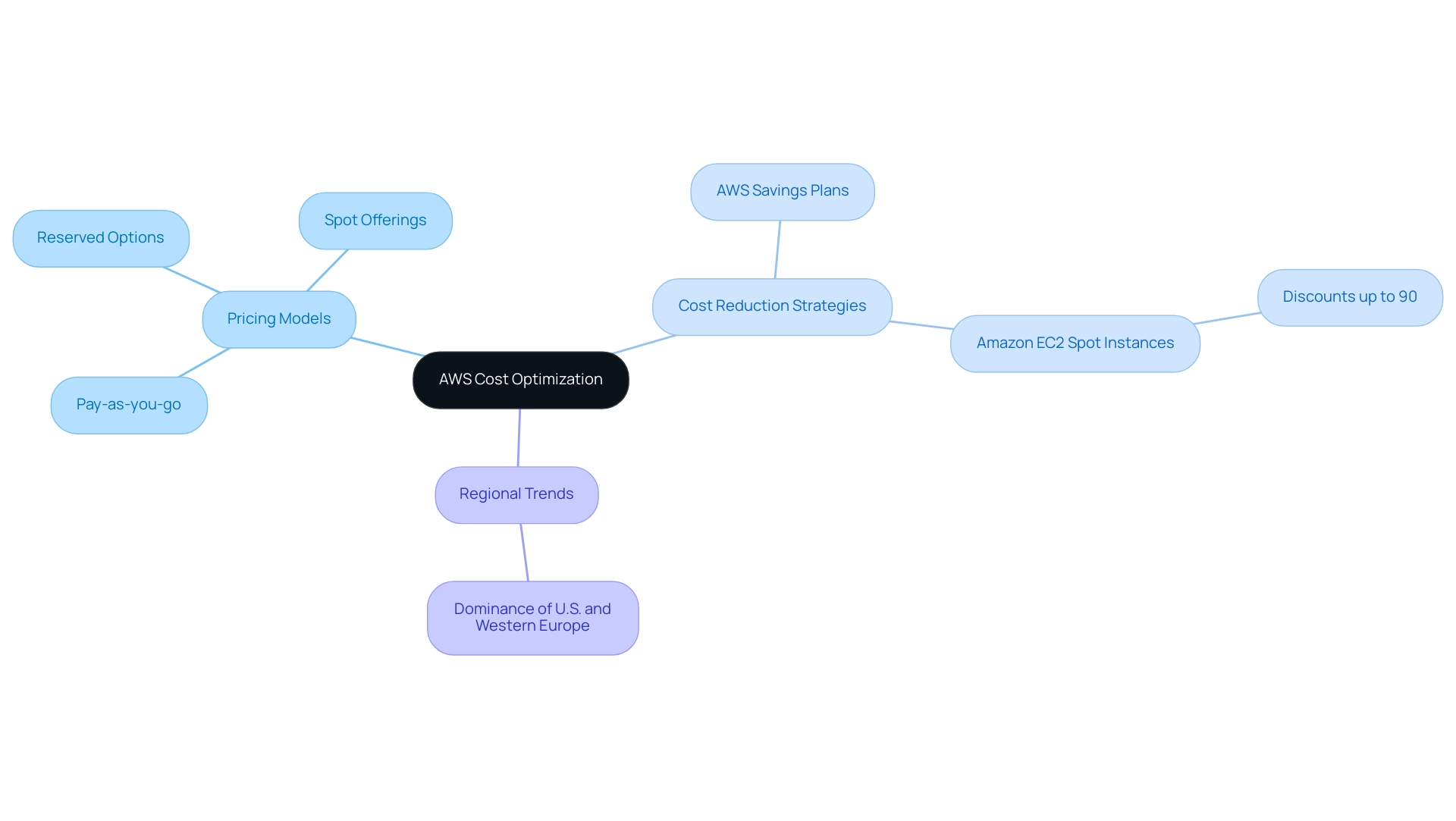
Top Strategies for Reducing AWS Costs: Right-Sizing and Reserved Instances
Right-sizing is an essential approach in AWS expense management that utilizes AWS cost reduction strategies, concentrating on the careful examination of resource usage to guarantee that AWS resources align perfectly with current workload requirements. This involves not only adjusting resource sizes but also eliminating idle assets, such as On-Demand resources used for non-production operations, to avoid unnecessary charges. By effectively implementing right-sizing as part of their AWS cost reduction strategies, companies can avoid the pitfalls of over-provisioning, which often leads to inflated costs.
For example, migrating from a c4.8xlarge EC2 server to a c4.4xlarge can yield savings of $190 every 10 days, illustrating the tangible financial benefits of this practice. Moreover, the adoption of reserved configurations is one of the AWS cost reduction strategies that enables organizations to commit to specific types over a longer duration, resulting in substantial savings when compared to traditional on-demand pricing models. This strategy not only optimizes resource allocation but also fosters a more cost-effective AWS environment by implementing AWS cost reduction strategies.
It is essential for businesses to continuously evaluate their AWS resources and adjust instance sizes as part of their AWS cost reduction strategies, whether through immediate changes or during designated maintenance windows, to maximize efficiency and minimize expenses. As TSO Logic notes, "84% of enterprises can run on smaller footprints but need more knowledge to become wise," highlighting the importance of ongoing education in effective cloud management and the necessity of making right-sizing an ongoing process.
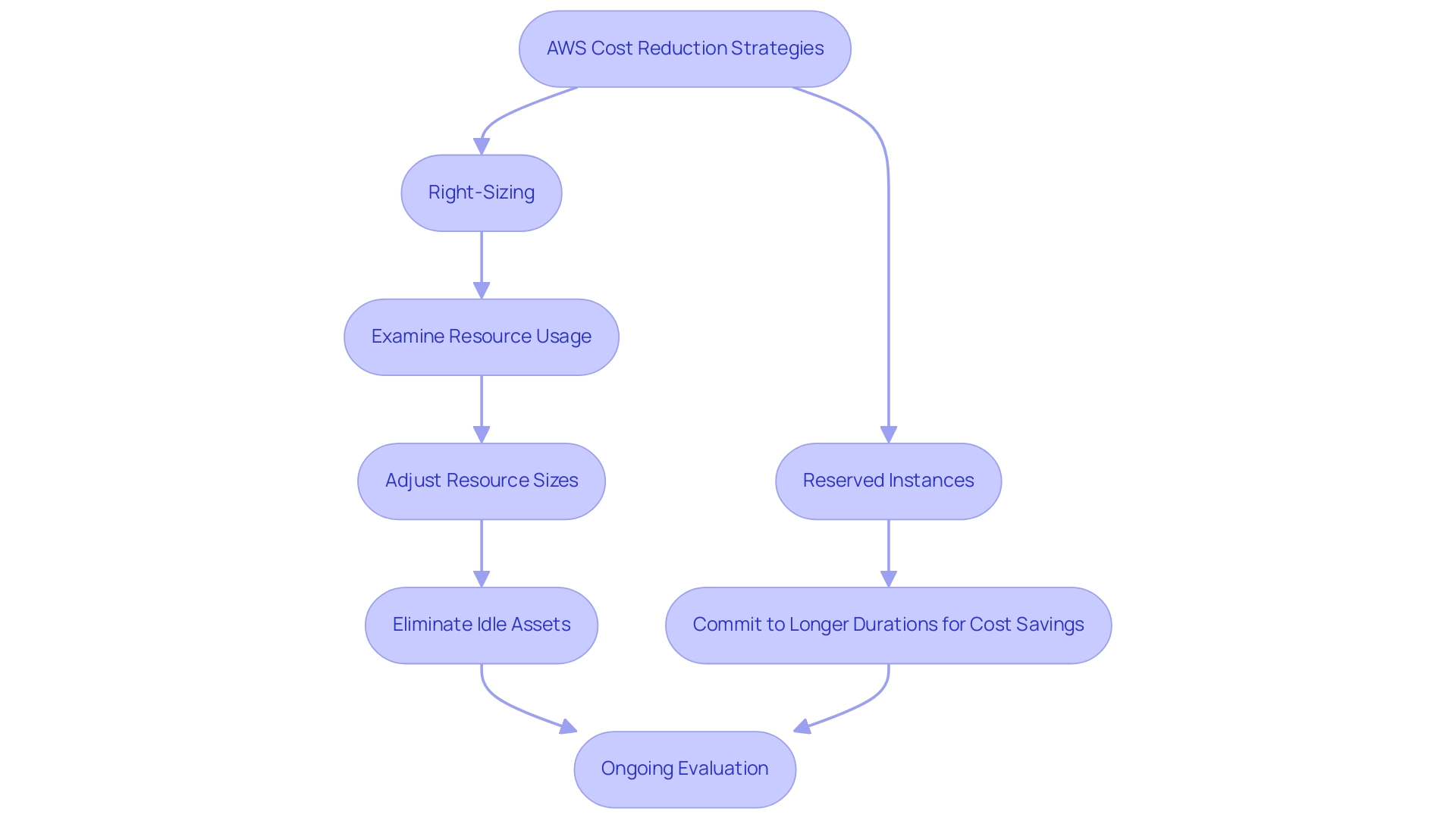
Leveraging AWS Tools for Effective Cost Management
AWS provides a robust suite of tools for effective expense management, prominently featuring AWS Cost Explorer and AWS Budgets. AWS Cost Explorer enables organizations to visualize their spending patterns through intuitive graphs and charts, facilitating the identification of expenditure trends over time. This tool is particularly useful for generating custom reports, which can be saved and shared across teams to explore various datasets.
In contrast, AWS Budgets enables users to set customized spending and usage budgets, providing alerts if expenditures exceed predetermined thresholds. This feature is essential for maintaining financial governance and preventing overspending. Grasping the difference between AWS Cost Explorer and AWS Cost and Usage Reports is crucial; while Cost Explorer presents a high-level overview with visual representations, the Cost and Usage Reports provide a granular, line-item breakdown of expenses, making it suitable for teams requiring detailed billing and integration with advanced analytics tools.
By strategically employing these tools, entities can extract actionable insights into their AWS expenditures, which can inform decision-making and enhance efficiency through AWS cost reduction strategies. As Cody Slingerland, a FinOps certified practitioner, emphasizes, effective collaboration with internal teams to leverage these tools is vital for maximizing cloud investment. Furthermore, the latest features and updates from AWS enhance the capabilities of these tools, solidifying their role as essential resources for entities aiming to manage their cloud expenses efficiently.
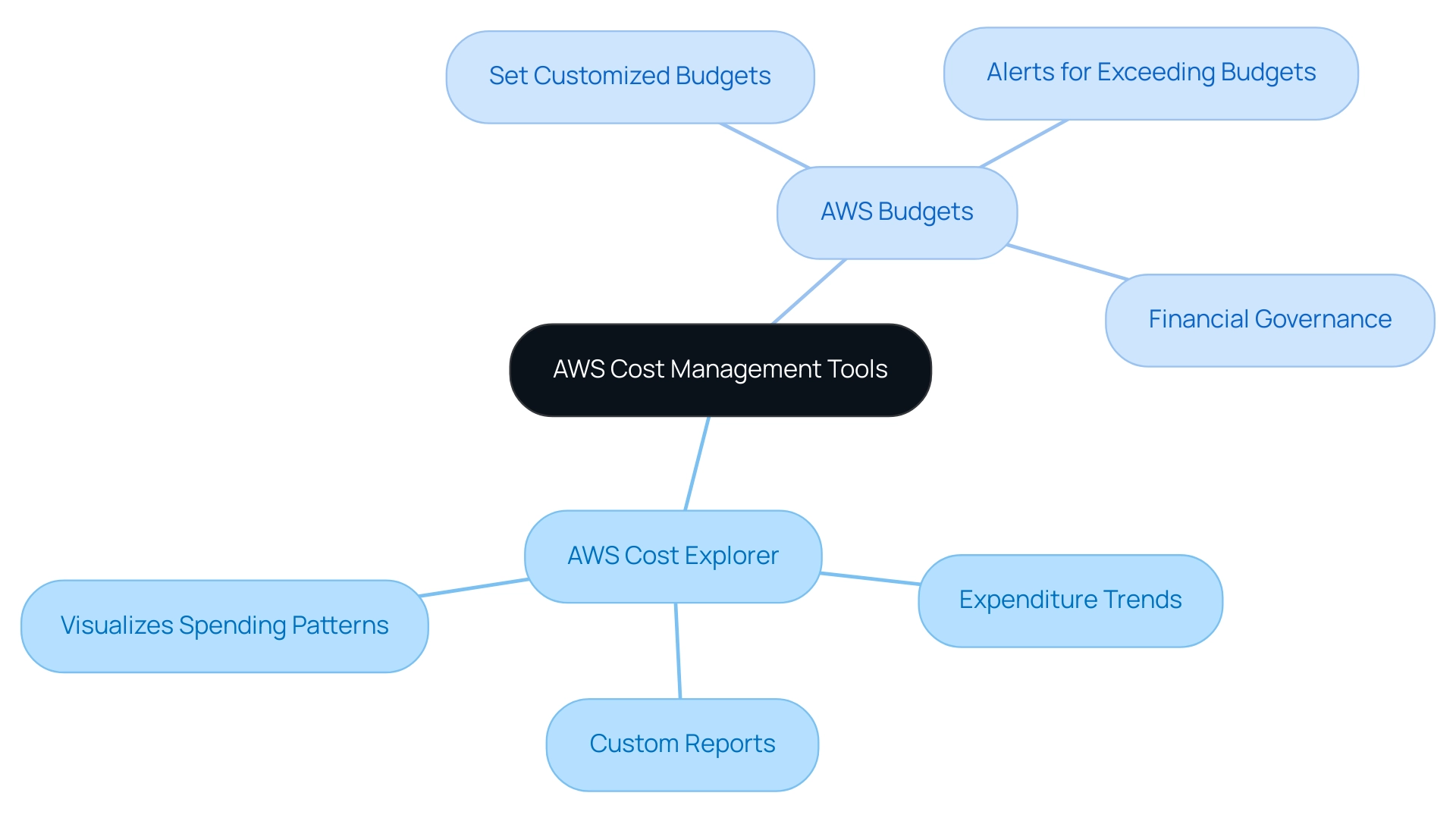
Optimizing Storage and Data Transfer Costs in AWS
To effectively utilize AWS cost reduction strategies, companies must conduct a thorough evaluation of their storage classes and leverage Amazon S3 Intelligent-Tiering to reduce storage expenses within AWS. This service automatically manages data between two access tiers based on changing access patterns, ensuring that entities only pay for the storage they need. Given that the U.S. and Western Europe account for 82% of the world’s cloud computing, optimizing storage solutions has become paramount in these regions.
Furthermore, organizations can significantly lower data transfer expenses by utilizing AWS Direct Connect, which offers a dedicated network connection, or by optimizing their architecture to mitigate unnecessary data transfers between regions. A notable example of successful expense management includes Drift, which saved $2.4 million annually through strategic AWS integration, demonstrating that informed management of storage and data transfer can lead to substantial reductions in AWS expenditures by utilizing AWS cost reduction strategies. As StormForge appropriately noted, "Most companies reported that as their cloud spending increased, so did their cloud waste," emphasizing the urgent need for effective financial management strategies.
Furthermore, AWS Budgets allows users to establish and implement budgets for AWS services, which serves as a practical tool for entities to enhance their financial efficiency using AWS cost reduction strategies. By implementing AWS cost reduction strategies, entities can not only enhance their financial management but also align with best practices in cloud operations.
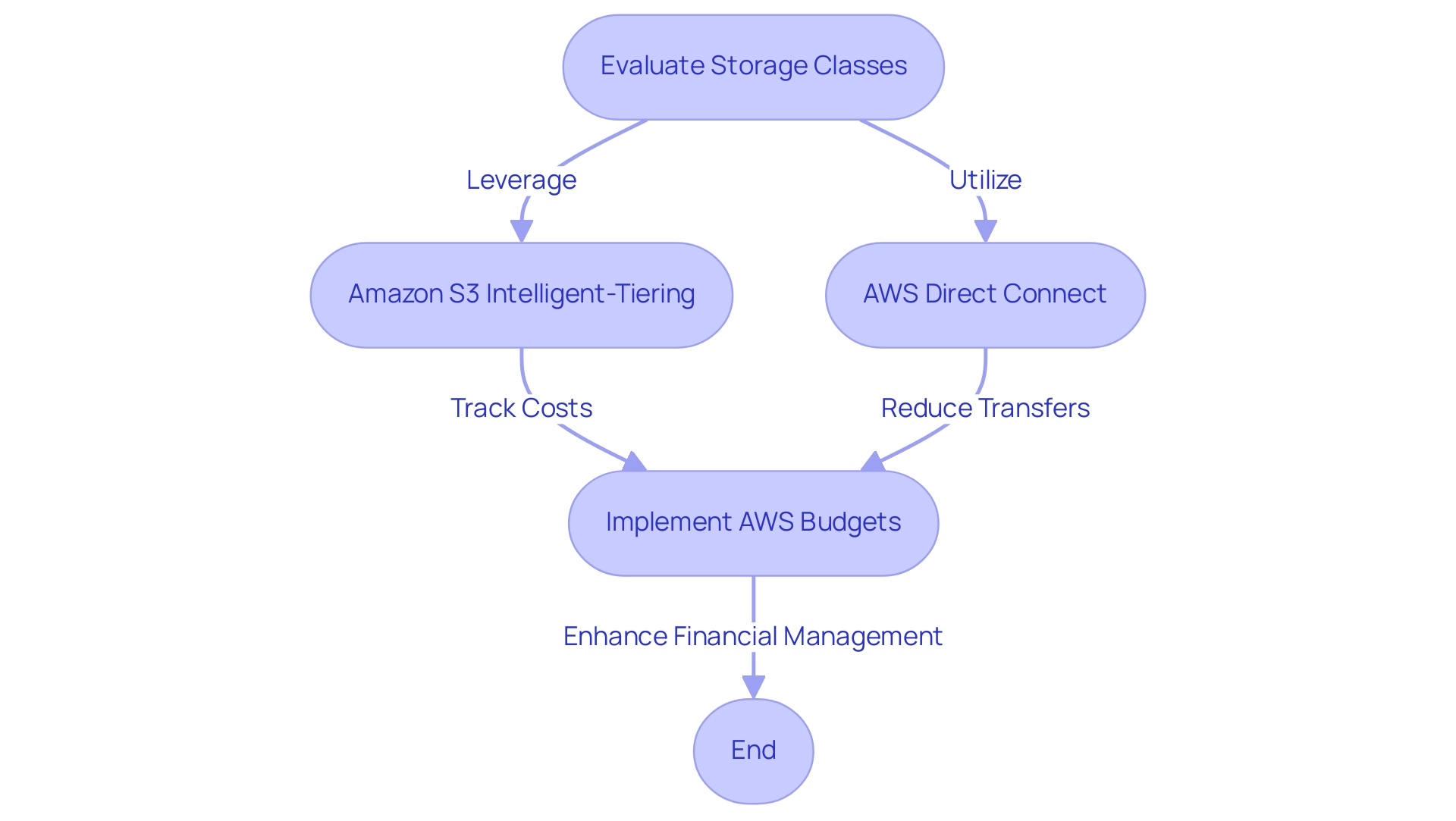
Advanced Cost Reduction Techniques: Spot Instances and Savings Plans
AWS Spot Instances present a compelling opportunity for organizations to adopt AWS cost reduction strategies by bidding on unused EC2 capacity at discounts of up to 90% compared to standard on-demand pricing. This model is especially beneficial for applications that are adaptable and fault-tolerant, enabling businesses to decrease expenses significantly while preserving performance. For instance, Mike North, the NFL VP of Broadcasting Planning, highlights the effectiveness of this approach, stating,
Leveraging Spot Instances to build the season schedule has enabled the NFL to save over $20 million since 2014.
In tandem with Spot Instances, AWS Savings Plans offer a flexible pricing model that can lead to substantial AWS cost reduction strategies. By committing to a predetermined level of usage over one or three years, entities can unlock significant savings while ensuring they have the capacity to meet their operational demands. Recent developments indicate that as the capacity crunch has affected not just specialized types, such as GPU types, but has gradually spread to general-purpose types, the strategic use of both Spot Instances and Savings Plans becomes increasingly crucial.
This capacity crunch necessitates a careful approach to resource allocation, as entities must navigate limited availability while maximizing their cost-saving opportunities. Moreover, the implementation of an Attribute-Based Type Selection (ABS) strategy allows users to define their requirements based on specific attributes like vCPU, memory, and storage. This approach complements the use of Spot Instances and Savings Plans, ensuring optimal flexibility in configuration and aiding in selecting the most appropriate instance types for various workloads.
By effectively integrating Spot Instances, Savings Plans, and ABS into their AWS cost reduction strategies, organizations can achieve remarkable cost efficiencies while enhancing operational effectiveness in the cloud.
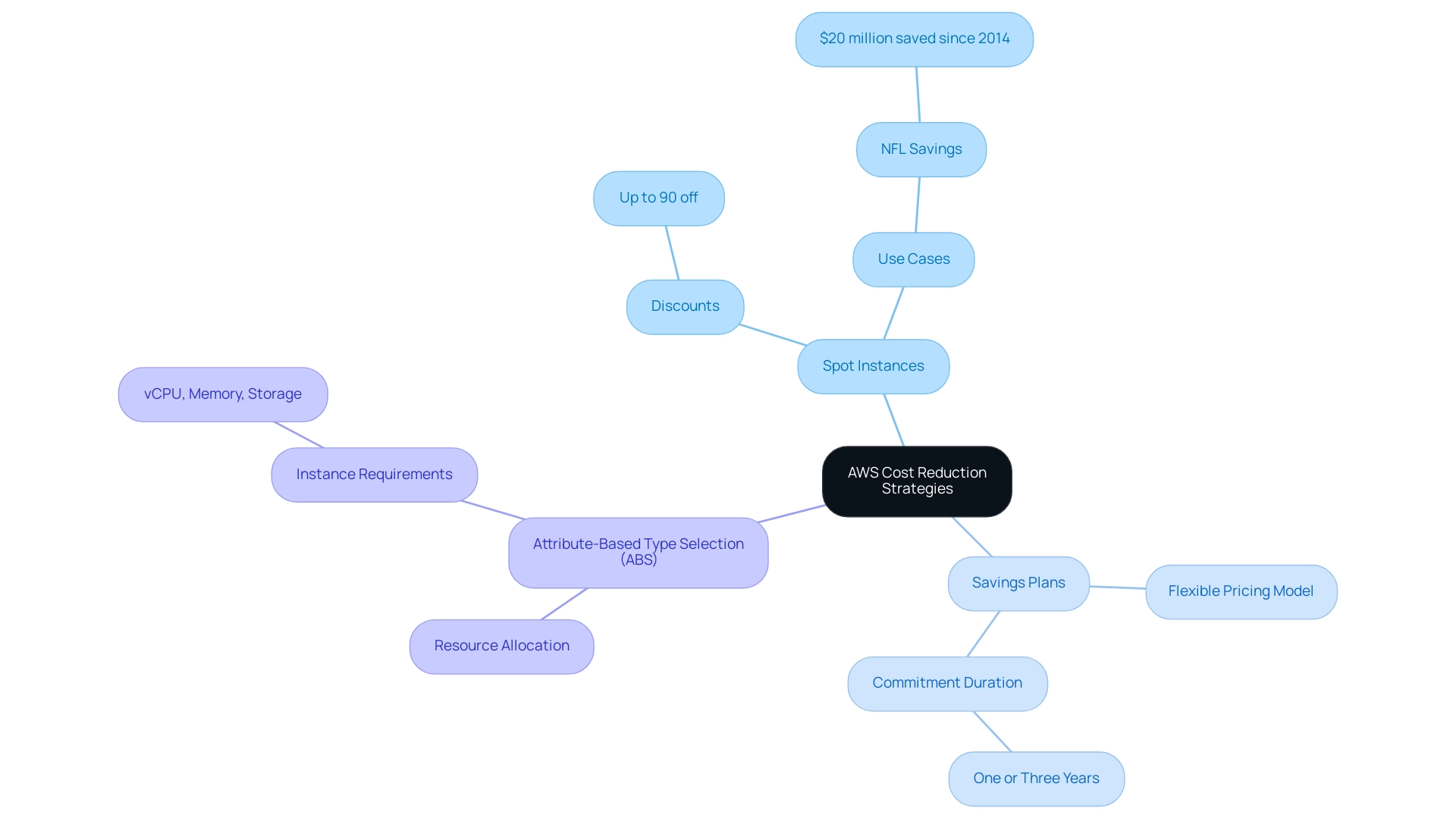
Conclusion
Mastering AWS cost optimization is essential for organizations seeking to maximize their cloud investments. Through a comprehensive understanding of AWS pricing models, including pay-as-you-go, reserved instances, and spot instances, businesses can unlock significant savings and enhance operational efficiency. Strategies such as right-sizing and the adoption of reserved instances empower organizations to align their resource utilization with actual workload demands, ensuring that costs are minimized while performance remains high.
Leveraging AWS tools, including Cost Explorer and AWS Budgets, further facilitates effective cost management. These resources provide organizations with the insights necessary to monitor spending patterns and set appropriate budgets, thereby preventing overspending and fostering a culture of financial accountability. Additionally, optimizing storage and data transfer costs through services like Amazon S3 Intelligent-Tiering and AWS Direct Connect allows businesses to streamline expenses and align with best practices in cloud operations.
Moreover, advanced techniques such as utilizing spot instances and AWS Savings Plans present lucrative opportunities for cost reduction. By strategically bidding on unused capacity and committing to consistent usage levels, organizations can enjoy substantial discounts while maintaining flexibility in their operations. The integration of these strategies not only enhances financial performance but also positions businesses for sustainable success in the ever-evolving landscape of cloud computing.
In conclusion, the journey towards effective AWS cost optimization is multi-faceted, requiring a blend of strategic planning, continuous evaluation, and the adept use of available tools and resources. By prioritizing cost management, organizations can not only improve their bottom line but also foster resilience and agility in their cloud operations, paving the way for future innovation and growth.




